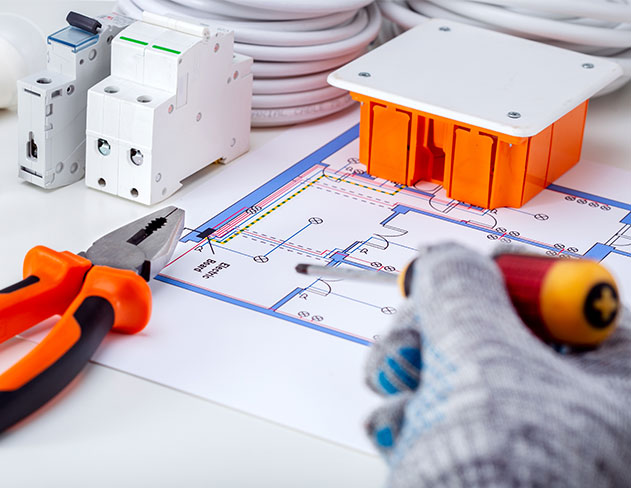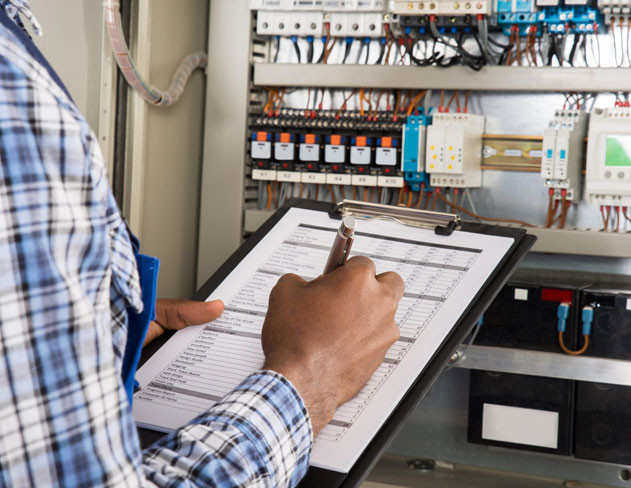Breaking Down EICR Costs for Landlords: What to Expect and How to Budget
Ensuring the safety of tenants through regular electrical checks represents a fundamental responsibility for UK landlords. As regulations rightly continue tightening to uphold rigorous safety standards – the importance of understanding associated costs comes into sharp focus.
This guide will examine precisely what to budget for EICR inspections depending on property type and size. We’ll also explore the key factors influencing pricing, from system complexity to experience level of the certified electrician conducting testing.
By clearly highlighting the EIRC cost for landlords, alongside a breakdown across rental property configurations, landlords can better plan budgets. We’ll outline best practices for funding testing cycles as part of long-term ownership obligations.
Meeting evolving compliance regulations does entail financial commitment – but crucially protects all involved while upholding building suitability. Let’s explore EICR specifics for informed planning that keeps occupants safe.
Key Findings:
- Overview of EICR importance and landlord obligations
- Breakdown of average costs ranging from £80 – £140 depending on rental size
- Comparison table illustrating quotes for studios to 6-bed houses
- Framework for funding regular testing milestones
- Guidance on financing potential remedial repairs
- Exploring why certified electricians prove critical
- More comprehensive landlord duties spanning responsiveness, upkeep and oversight
- Profile of Hexo as trusted safety inspection experts
Overview of EICR and its Importance for Landlords
EICR stands for “Electrical Installation Condition Report”. It constitutes a detailed inspection providing a comprehensive analysis of the safety, quality and maintenance status of a rental property’s fixed wiring and electrical circuits.
Certified electricians conduct testing across all connected systems, including the consumer unit, lighting circuits, sockets, isolators and fixed appliances.
The in-depth appraisal aligns with industry standards BS 7671 and IET to identify any damage, wear and tear, potential fire hazards or shock risks from exposed wires or faulty earth connections, etc.
EICR delivers insightful grading to landlords on the existing state of electrical fixtures while flagging any remedial work required to restore safety. This allows appropriate planning and budgeting for essential repairs or upgrades.
Regular EICR inspections represent a critical part of responsible rental ownership. As of June 2020, new legislation makes testing mandatory every five years – with reports provided to tenants.
Ensuring full compliance protects all parties while signalling reputable standing as a landlord committed to occupant wellbeing through stringent safety management.
Average Cost of EICRs
When planning budgets for periodic EICR inspections, costs largely depend on rental property size, together with the complexity of its electrical circuits and connected systems. As shown in the table below, indicative pricing for landlords spans £80 to £170, dependent on these factors:
Factors that Influence the Cost of EICR Inspections
- Size of home
- How many circuits are in the home
- How many consumer units/ fuse boxes you have
Comparing Costs Across Different Property Types and Sizes
| Type | Weekday 8 am-5 pm | Weekday Evening, 5 pm- 10 pm | Weekend 8 am-6 pm |
| Studio | £80 | £110 | £80 |
| One-bedroom Property | £90 | £120 | £90 |
| Two-bedroom Property | £100 | £130 | £100 |
| Three-bedroom Property | £110 | £140 | £110 |
| Four-bedroom Property | £120 | £150 | £120 |
| Five-bedroom Property | £130 | £160 | £130 |
| Six-bedroom Property | £140 | £170 | £140 |
As evidenced in the above ranges, landlords can expect to pay between £80 and £170 depending on the property type and when they would like the work completed. Final quotations also consider regional variances in labour costs factored by the appointed electrician.
Of course, identifying serious faults requiring urgent remediation may entail additional expenses as repairs or part replacements are actioned. However, restoring safety remains non-negotiable for ongoing tenancy.
With clear insight into average pricing, setting aside requisite funds as part of long-term budget planning ensures regulatory testing always gets noticed while providing tenants peace of mind.
Budgeting for EICRs as a Landlord
As regular electrical testing represents an obligatory requirement, planning allows landlords to fund inspection cycles without financial burden appropriately. By understanding estimated costs based on property size together with preparing for any required remedial upgrades – you can sustain safety for occupants in a compliant and stress-free manner.
Setting Aside Funds for Regular Electrical Safety Checks
The latest regulatory guidelines enforced from June 2020 mandate that EICR testing be conducted once every five years. This means most landlords will need to fund inspection at least 4-5 times over a typical ownership period.
By referencing the average pricing table, setting aside funds in advance each tax year ensures available capital when testing milestones approach. For example, owners of 3-bedroom houses can aim to save £110 on an annual basis to cover future liability.
The focus should centre on smoothing expenses over time rather than reacting with urgency whenever compliance deadlines loom. Integrating recurring EICR budgets into round financial planning allows for proactively upholding safety for all residents.
Understanding the Potential Expenses of EICRs and How to Plan for Them
While conducting rigorous testing across electrical systems, EICRs may identify faults requiring prompt repair or part replacements to restore safety. Where deterioration occurs, electricians provide detailed specifications, including the recommended upgrades and indicative parts/labour expenses.
As faults could potentially impact multiple circuitry or installations, it’s difficult to accurately estimate expense ranges accurately should rework results be necessary. However, as a guide based on the table below, landlords may want to set aside contingency funding equivalent to 15% of the original EICR quote to finance any minor repairs. For more significant upgrades identified, additional capital may need allocation after cost estimation by the electrician.
| EICR Cost | 15% Contingency Fund |
| £80-90 | £15 |
| £100-120 | £20 |
| £130-140 | £25 |
Taking a prudent approach focused on regularly topping up this contingency funding allows for swiftly addressing unexpected faults without financial stress. Most importantly, this keeps tenants safe while upholding compliance as properties remain habitable.
Importance of Hiring a Qualified Electrician for EICR Inspections
While attempting cost savings, too often landlords appoint inexperienced technicians or take DIY approaches to obligatory electrical testing. This severely compromises accuracy – failing to spot underlying faults while providing false comfort. Utilising accredited professionals ensures precision.
Ensuring Compliance with Electrical Safety Standards
To deliver authoritative landlord certificates aligned with legal guidelines, electricians must complete rigorous training and meet the competencies required by the BS 7671 to be qualified. This can be done through JIB training, apprenticeships and vocational training.
DIY testing often provides rudimentary insights based only on surface-level faults. Approving unsafe systems fails to uphold tenant safety while leaving landlords non-compliant if issues emerge later. Certified experts prevent such scenarios.
Benefits of Working with a Professional for Peace of Mind and Safety
Beyond assured compliance through expert testing, appointing certified electricians to conduct EICRs provides complete peace of mind. Their competence guarantees no underlying electrical hazards get overlooked – saving lives by preventing fires or electric shocks.
With thorough inspection and detailed supporting reports, they also guide appropriate repair prioritisation while communicating risks. This keeps all occupants safe while informing necessary maintenance.
Other Landlord Responsibilities
While electrical safety represents a major obligation through mandated EICR testing, various secondary duties also exist to provide tenants with safe and legally compliant housing. Core areas include:
- Ensuring prompt repairs when issues emerge – addressing problems raised in EICR reports and general wear & tear through drainage/plumbing replacements, appliance faults, etc. Clear communication channels also allow tenants to flag concerns directly.
- Quick and efficient response to all tenant repair notifications then becomes imperative. This stops minor problems from escalating into safety hazards while providing responsive service.
- Equally important – is listening to occupants through open dialogue while welcoming suggestions for improvements. This nurtures positive relationships where people feel valued, not just a source of income.
- Remaining hands-on through regular property inspections and check-ins enables proactively addressing areas of concern, too – rather than just reacting when systems fail.
Final Thoughts: Using Hexo to Keep Your Properties Safe
As we have covered, ensuring ongoing electrical safety for rented residences is indispensable to ethical, lawful ownership. Yet, between evolving regulations, expansive inspection scope, and potential budget impacts, the process also remains multifaceted.
Here at Hexo, our expertise, coupled with utilising the latest testing instrumentation, allows taking this burden fully off your shoulders. Our certified electricians leverage that in-depth knowledge to conduct accurate, comprehensive EICRs across London, Greater London, and Southeast rental properties on behalf of landlords.
We enable staying compliant with detailed reporting that builds future maintenance visibility while providing authoritative certification for your records and tenant transparency. Our pricing also promises to deliver inspection rigour cost-effectively through transparent quoting aligned to market rates.
For rapid EICR inspection by accredited electricians equipped to provide authoritative landlord certificates, please contact Hexo today. We make the process smooth while helping conscientiously uphold tenant safety over the long term.
FAQS
What does an EICR inspection include?
EICR testing involves in-depth analysis of a property’s electrical installation to identify any damage, wear and tear, potential fire or shock risks. Certified electricians will check all connected systems, including consumer units, lighting circuits, sockets, isolators and fixed appliances, against industry standards.
How much does an EICR cost for a 3-bedroom house?
For a typical 3-bedroom house, landlords expect to pay between £110 and £140 for an EICR inspection. Final costs depend on the number of electrical circuits requiring testing and local labour rates—larger houses with more systems to inspect at upper-cost bounds.
Should I use a qualified electrician for EICR testing?
Yes, only competent certified electricians accredited by bodies like NICEIC and ECA with rigorous ongoing training should conduct EICRs. Their expertise guarantees compliant reports, while their inspection precision identifies any safety issues a non-specialist could miss.
How often do rental properties need an EICR?
The currently enforced guidelines mandate all private rental properties in the UK undergo an EICR every five years. As a landlord, you must register new properties by April 2021 and inspect existing rentals within the next five years to retain compliance.
What if faults are found during an EICR?
Where faults are identified, the electrician will provide remediation recommendations, including parts needing replacement and estimated labour costs for prompt repairs by a certified specialist. As a landlord, you must correct issues while keeping tenants informed throughout the process for accountability.

